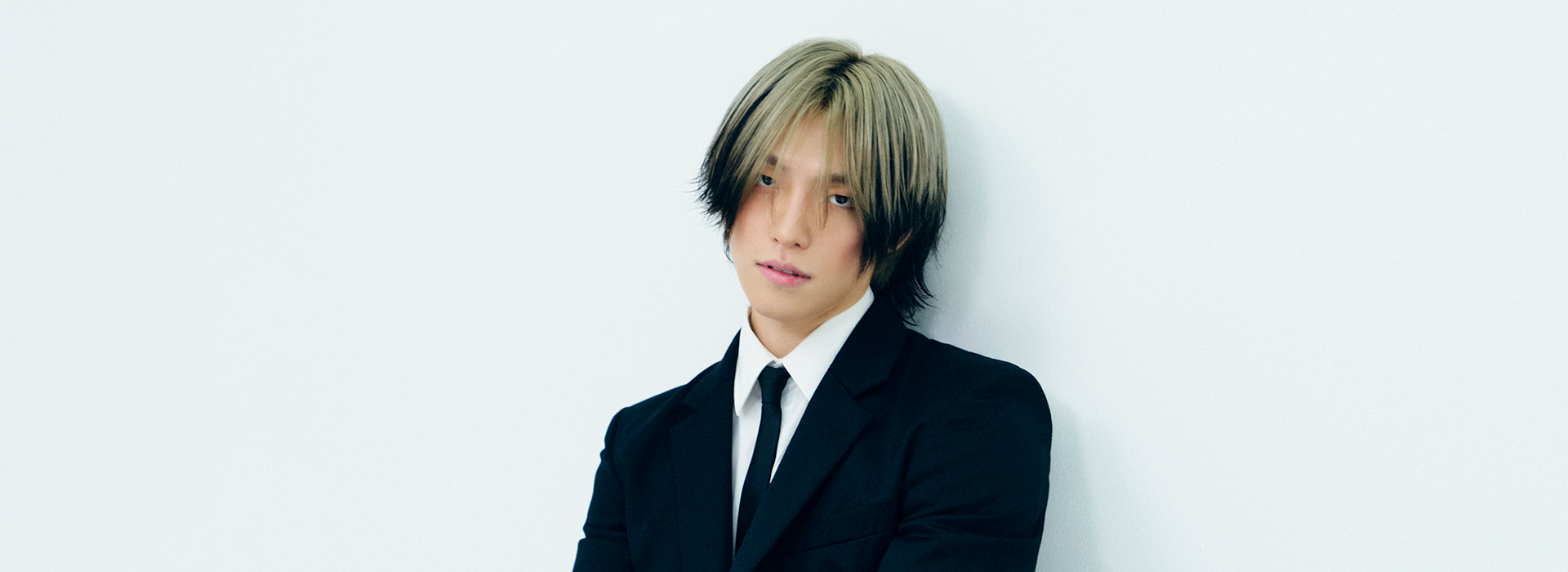
You’re releasing “Wait” as the fourth volume of SEVENTEEN’s TTT. Have you shown it to the other members of the group? (Note: This interview took place on October 19, before the release of “Wait.”)
DINO: We were practicing “God of Music” recently, and when we were done, I showed it to all of them. In the practice studio.
Oh, a screening. Classic SEVENTEEN. (laughs)
DINO: Yes. So we had a screening (laughs) and the members said it was really cool, and they meant it. SEUNGKWAN doesn’t usually say things like this to me (laughs) but he said, “Whoa, DINO! It’s amazing. I’m serious.” So I was ecstatic.
What was it like doing everything by yourself?
DINO: Ah … It definitely wasn’t easy. It was hard not having the other members around to rough it out with me. I practiced solo every time after practicing “God of Music” without fail. I even lost two or three kilograms in a single day. It was exhausting—I had to practice three times a day. They all tried to make me feel better by saying things like, “Wow, DINO, you must be exhausted,” or, “It was hard for me, too, when I was doing ‘Spider,’” and hearing these things made me almost tear up. I’m so happy that all 12 of them said they’re going to come by when I’m shooting the music video.
-
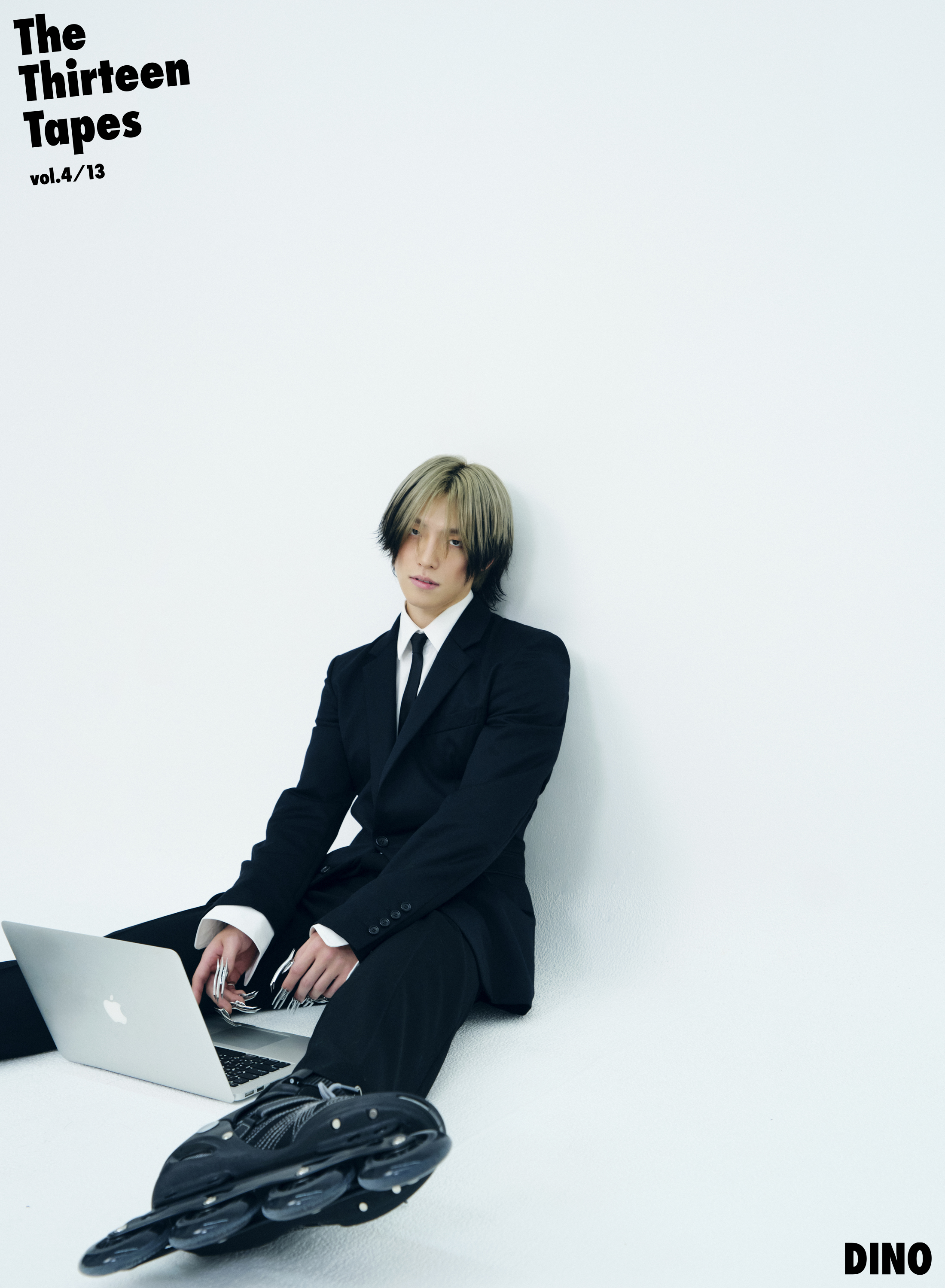 Satin jacket and tie by JOHNLAWRENCESULLIVAN, shirt by LEE y. LEE y., boots by JOHNLAWRENCESULLIVAN×GROUNDS, pants from stylist’s personal collection.
Satin jacket and tie by JOHNLAWRENCESULLIVAN, shirt by LEE y. LEE y., boots by JOHNLAWRENCESULLIVAN×GROUNDS, pants from stylist’s personal collection.
I bet it was extra special making “Wait” since you were doing it with WOOZI. I know the two of you talk about music a lot together.
DINO: It wasn’t that long ago that I started working on songs. I can come up with ideas for things for the verse, pre-chorus, hook—all the parts separately—but it’s still hard for me to see the big picture. But WOOZI’s great at that. He was always good at taking the lead, so when I told him my ideas, he’d say, “You should change this part, then it’ll make your idea work better.” I learned so much. He’s amazing. The song was really sad and melancholy at first, but I had an image I wanted to portray in mind and WOOZI helped fix it up during all the times we got together. Sometimes the songwriting process took us on wild tangents (laughs) and sometimes we tried layering different melodies on top of the vocals. TTT has given our group an opportunity, and I would like it to be like a pre-release, not a single or a solo album. I want it to show people what I’m aiming for. I’ve already done a lot of elaborate performances, so I liked how relatively simple “Wait” is.
It’s got a very simple beat and at times the chorus is nothing but the beat. It feels like that was a deliberate choice to make the song more laid-back.
DINO: My vocals and dancing would’ve been a lot different if I had set out to make it more intense and performative, but I wanted to portray the real me. I usually prefer more quiet places.
Are you drawn to things that are more chill when you have personal time?
DINO: Maybe it’s because my job is inherently a flurry of activity, but when I’m on my own, I try to keep things as chill and calm as possible. I started listening to calming songs that I could relate to. I used to put every last ounce of my energy into everything I do. I would be tense and put in everything I’ve got, so I was really worried I would get tired and it would stop being fun. So it was born out of trying to figure out how I could make things a little more fun while working, but I realized I could create more interesting things the more I loosened up.
What do you occupy your mind with when you’re taking it easy?
DINO: For the past few years I’ve been taking trips to go walk by the oceanside. I feel serene when I come back home after taking a trip. I can empty my mind completely when I travel. I can’t work even if I want to. It’s not like I’m going to rent a practice studio if I’m down in Busan, for example. I think the best thing for me is to travel and just be in the moment.
-
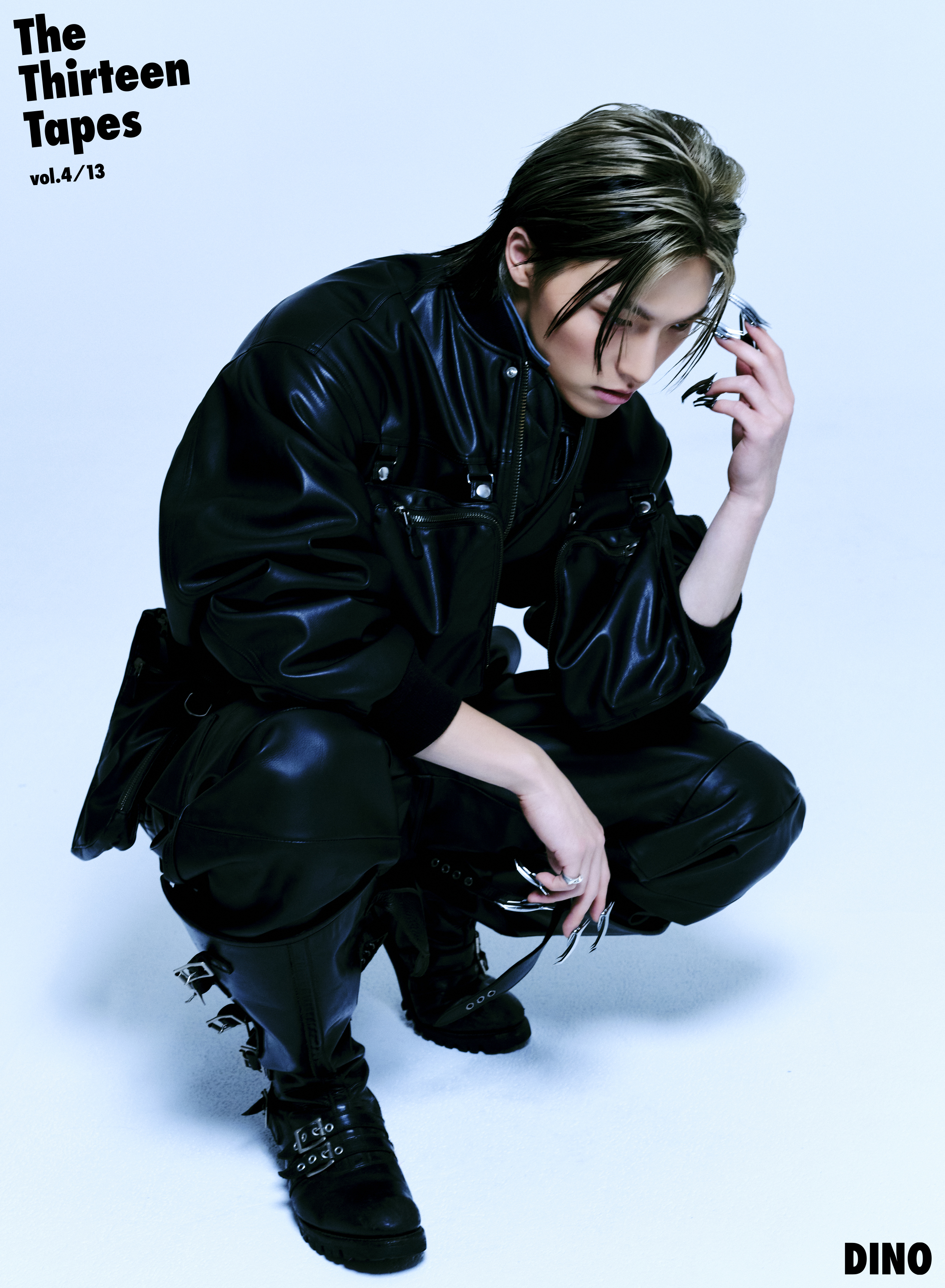 Blouson and pocket bag by G.V.G.V., jacket around waist and leather tie by LEE y. LEE y., leather pants by 1017ALYX9SM, shirt and belt from stylist’s personal collection, boots from styling assistant’s personal collection.
Blouson and pocket bag by G.V.G.V., jacket around waist and leather tie by LEE y. LEE y., leather pants by 1017ALYX9SM, shirt and belt from stylist’s personal collection, boots from styling assistant’s personal collection.
That idea of not overthinking and just taking it easy is prevalent in “Wait,” I think. You sound so relaxed, the way you sing the melody.
DINO: I spent a lot of time thinking about my vocals and changing the way they sounded. I know what my strengths are vocally, but I only show a little of it with SEVENTEEN and would switch it up depending on the vibe. I focused on using exactly the tone I wanted in “Wait” because I wanted to demonstrate my strengths.
The song starts out subdued and you slowly bring the energy level up, and the same can be said about the choreography, like how you begin on the floor, moving just your fingers a little bit at first.
DINO: I told the choreographer Choi Youngjun that I wanted the dance to be fresh and original. We were having a fair amount of trouble with the chorus, so we both laid down, and then I said, “I could lie down at the beginning. Maybe that would work?” And he said, “I thought the same thing.” That’s how it starts, but the beat is so light at the beginning that I decided to start just by moving my fingers before I get up.
When you choose a song, do you consider the choreography that will go along with it as well?
DINO: For this song, I specifically had the choreography in mind while making it. I wanted to do something people wouldn’t ever expect me to. I’m the one in the group who’s always acting cute, cracking jokes, and keeping things light, but this time I wanted to be someone different on stage. And I think elaborate dance moves and ones that make people go “wow” are super impressive, but I think the most impressive dances are the ones that capture everyday movements and feelings, and the better you can do that, the more captivating they are. So there are moves in “Wait,” like a flick of the finger or making a “come here” motion, to which I put careful consideration in.
It’s just like you said on Weverse Live: “Everything can become a dance.”
DINO: I think dance is just one way to express a song. I put a lot of consideration into the song and performance as a whole. Throughout the whole song, I consider the dance moves and how they connect to my facial expressions, the message I’m conveying, and how I want the people who see and hear it to feel. It’s my hope that people pay a little more attention to what it is I want to convey alongside the dance. Now that I think about it, I never did a love song until “Wait.” I just did autobiographical songs. So I had to think carefully about what kind of love song would fit a 24-year-old me without sounding cheesy.
-
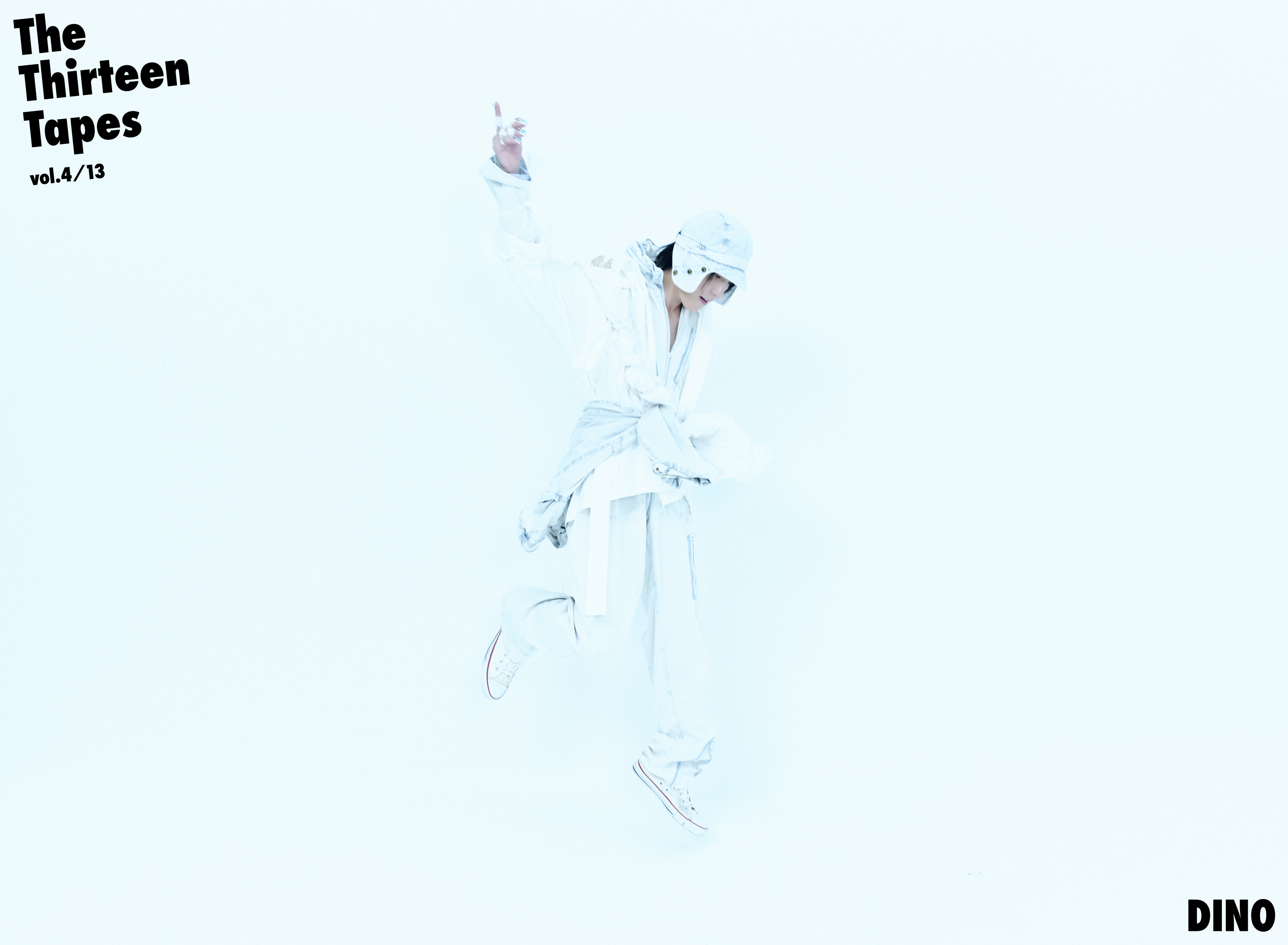 Jumpsuit, jacket around waist, and hat by HYEIN SEO, shirt by AMBUSH®, sneakers from stylist’s personal collection.
Jumpsuit, jacket around waist, and hat by HYEIN SEO, shirt by AMBUSH®, sneakers from stylist’s personal collection.
You dance by yourself in the first verse, rolling your body and doing other moves reminiscent of contemporary dance, then in the second verse, you’re joined by the female backup dancers to perform the same moves together. Later in the song, the dancers move independently of you. It’s as though the performance has a plot that starts with one being alone, meeting someone, and then being alone again.
DINO: I think that arose naturally because there’s a story in the song. I thought a lot about what to do with backup dancers on stage while working on the performance. I thought it made sense to do the song with female dancers, and I decided we should do exactly the same moves, really, really well, rather than me and one of the dancers dancing a duet.
Speaking of dancing “really, really well,” you do a lot of impressive moves from head to toe during the chorus, including those spins. How do you decide on the dance moves?
DINO: I chose whatever moves felt natural following the ones before them. You have to dance as naturally as possible so that anyone watching feels like it’s completely natural, too. Moving head to toe, then into a spin. And people who think about dance before anything else are used to dancing to the beat of any song they hear out of habit. Planning the choreo is important, and when you try to make it look cool, it naturally becomes more elaborate. It turned out the way it did because, while the choreographer was making the dance, he was like, Well, it’s DINO, after all—he can do it. (laughs)
Maybe it’s thanks to how much thought you put in that the whole performance flows so naturally even with all the details that go into each move. After seeing that, I got the feeling that you’re a very meticulous creative type.
DINO: Oh—you are absolutely right. Thank you. (laughs) I practice even the most specific details when I’m in the practice studio. When I’m on stage, though, I try to clear my mind. I try to work on my muscle memory when I’m practicing. I make sure to practice a lot so that I can get the perfect angle that shows the good side of my face even when I so much as turn my head. Then, when I’m on stage, I pour all my focus into the feeling and the emotions around me. It feels like my emotional side and my rational side are in perfect harmony when that happens.
It must take an awful lot of practice to get to that level. Isn’t it lonely dancing in front of the practice room mirror endlessly by yourself?
DINO: Of course. It’s hard. I’ve actually never told anyone this before, but I’m not good at dancing in front of the mirror.
Oh, really?
DINO: When I see myself in the mirror, I can’t dance properly. If I look in the mirror, all I see are my shortcomings, so I can’t really watch myself. I film myself dancing instead and review that post-practice. I can only watch myself when it’s from someone else’s perspective. I don’t think I can be objective if I’m just watching myself in the mirror, so I feel like taking a step back this way helps me improve.
It must take you twice as long if you’re reviewing like that.
DINO: It’s a truly rewarding process. When we practice as a group, too, we do it two times: dance once, film it, review the footage, see what we need to change, do it again, film it, review, and call it a day. It’s better than going, “Let’s just do this two or three times and get out of here.” I find it’s the most efficient, most rewarding way.
-
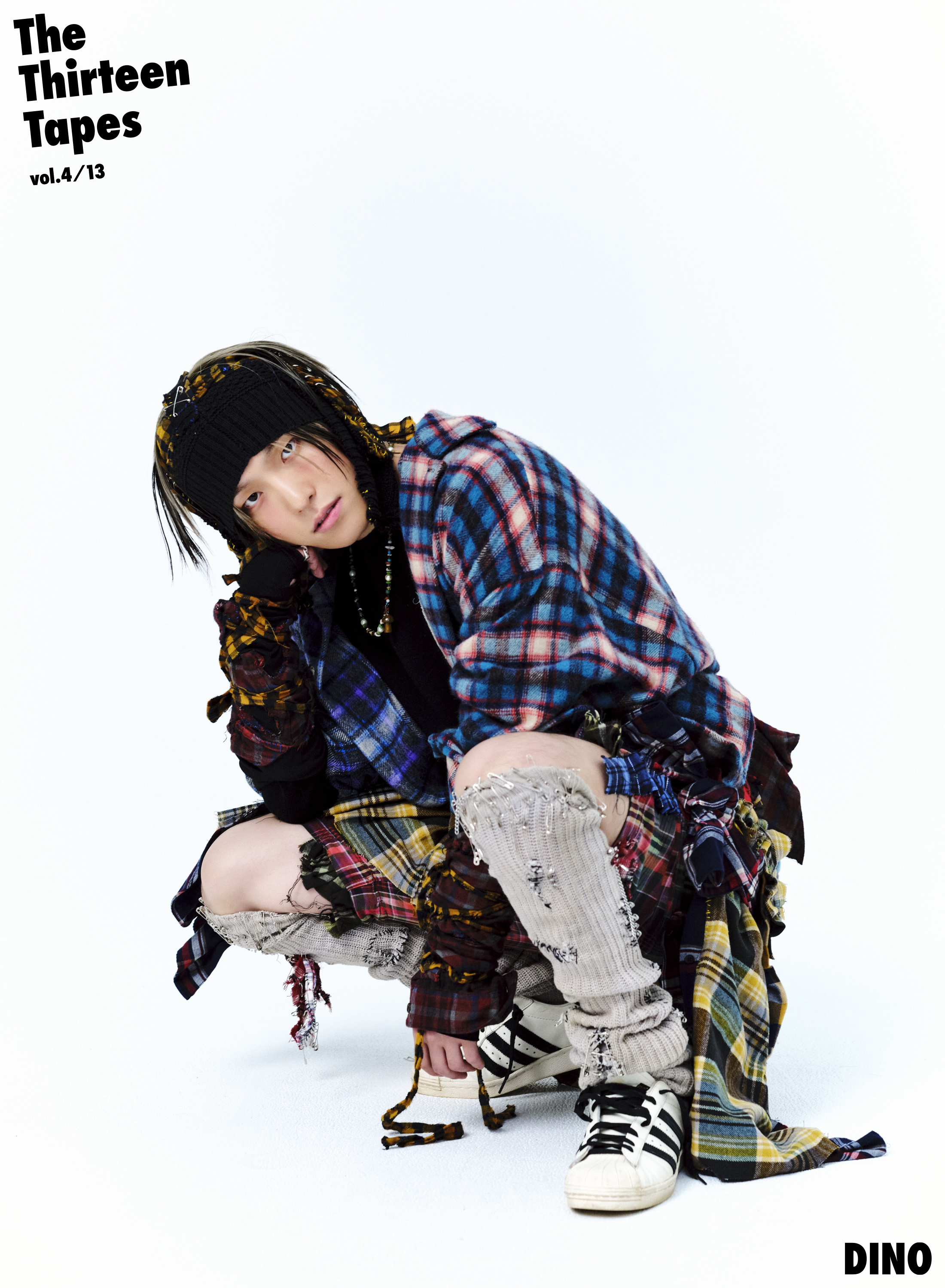 Plaid shirt by MAGIC STICK, vintage upcycled plaid shorts, upcycled plaid beanie, upcycled plaid arm cover, upcycled loose socks by Newsian, beaded necklace by Baaaaba&Newsian, vintage knit and sneakers from stylist’s personal collection.
Plaid shirt by MAGIC STICK, vintage upcycled plaid shorts, upcycled plaid beanie, upcycled plaid arm cover, upcycled loose socks by Newsian, beaded necklace by Baaaaba&Newsian, vintage knit and sneakers from stylist’s personal collection.
“Wait” is also the final product of constant self-review and improvement, it seems. Your performance seems to show what you learned from DANCEOLOGY, where you kept trying new things, like changing locations or contemporary dance.
DINO: You’re right. The most important thing I learned through doing DANCEOLOGY was intuition. If you don’t keep at it constantly, you lose it. Doing DANCEOLOGY kept me from losing my intuition when I was making or practicing choreography and helped me feel joy in dancing to this day.
You danced with VERNON, SEUNGKWAN, and MINGYU while doing DANCEOLOGY, although you all have different physical traits and dance styles. Now you have experience acting as the other members’ choreography director.
DINO: I certainly do. I get ideas for choreography just by watching the members. DANCEOLOGY changed the way I dance and gave me the assurance that I can now play with a wider range of emotions. The best part is when the members say they love it. “I like the choreography. It’s as good as the choreographies we grew up dancing to.” That kind of praise made me happy.
Judging from how cohesive your dances are despite making them on such a short notice, I assumed that you have often found yourself in similar situations.t. Do you often practice with another member if you see him practicing alone?
DINO: Yes, all the time. I dance with the members a lot. I stayed behind with DK to practice every day when we were doing “Super.”
What role do you play when you practice together?
DINO: I’m like, a cheerleader and assistant teacher? (laughs) They have no problem coming up to me with questions when they’re having trouble with a dance. That’s when I remember that dancing has to be fun, and instead of saying, “That’s not quite it,” I say, “That looks good, too!” And try to be encouraging to them that way.
In season two of In the SOOP, you said that while SEVENTEEN’s success is due to luck and good timing in part, the one thing that has nothing to do with luck is the teamwork. How is it that everyone in SEVENTEEN is able to work together so well?
DINO: I think it all comes down to communication. If you don’t speak up, nobody can know, right? It’s not like the group members tell each other everything—we all have different personalities. But there’s always someone who takes the lead, while some observe and accept the others’ perspectives for what they are. A big part of our strength comes from us being able to recognize what’s been on each other’s minds lately.
-
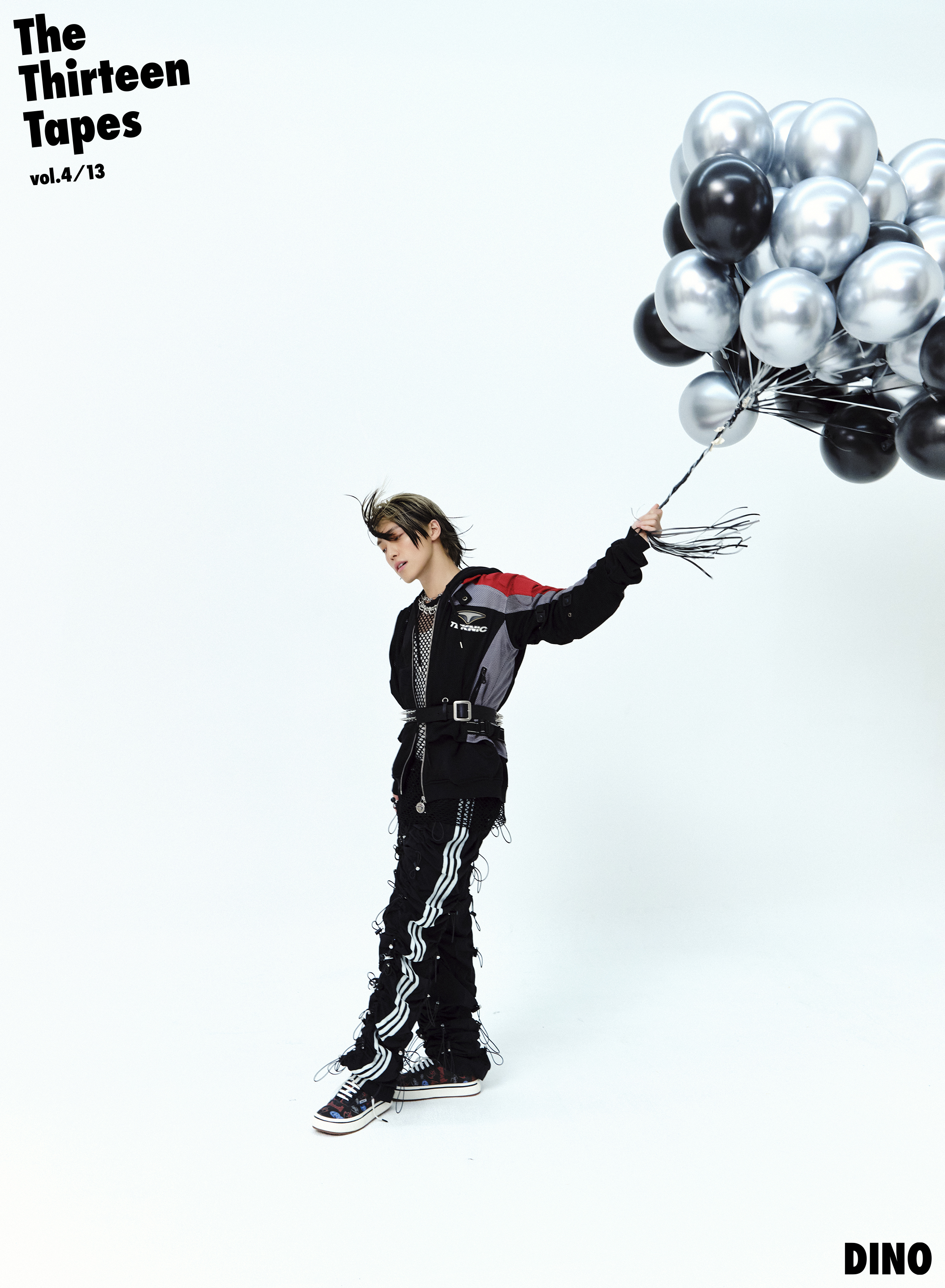 Mesh top by JOHNLAWRENCESULLIVAN, pants by 99%IS-, necklace (first) by 1017ALYX9SM, earrings, necklace (second), belt, and sneakers by AMBUSH®, jacket, and inner tank top from stylist’s personal collection.
Mesh top by JOHNLAWRENCESULLIVAN, pants by 99%IS-, necklace (first) by 1017ALYX9SM, earrings, necklace (second), belt, and sneakers by AMBUSH®, jacket, and inner tank top from stylist’s personal collection.
-
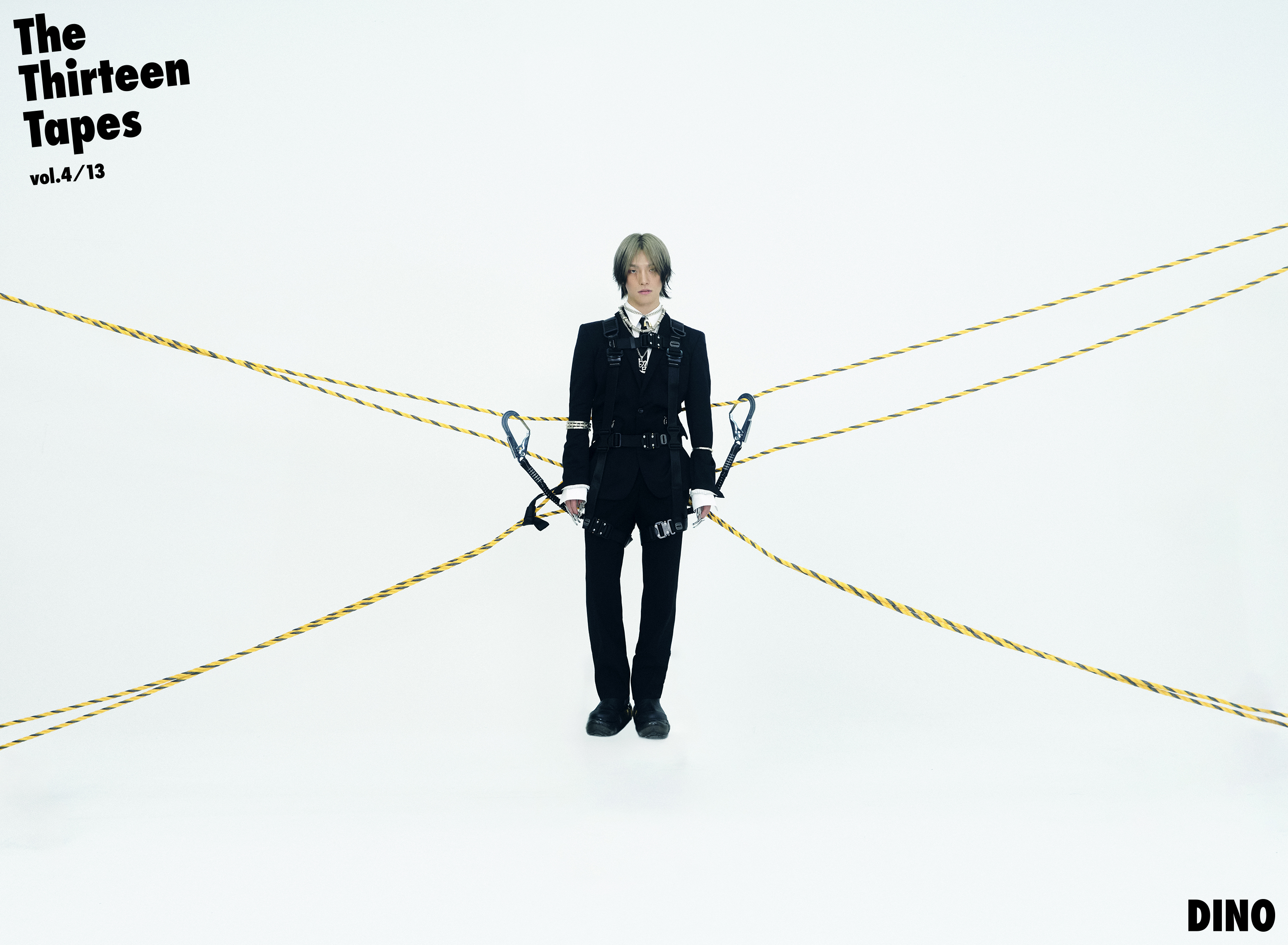 Satin jacket and tie by JOHNLAWRENCESULLIVAN, shirt by LEE y. LEE y., boots by JOHNLAWRENCESULLIVAN×GROUNDS, bamboo necklace, monument necklace, bamboo heavy bracelet (left) and bamboo bracelet (right) by ISHI.
Satin jacket and tie by JOHNLAWRENCESULLIVAN, shirt by LEE y. LEE y., boots by JOHNLAWRENCESULLIVAN×GROUNDS, bamboo necklace, monument necklace, bamboo heavy bracelet (left) and bamboo bracelet (right) by ISHI.
What message do you want to give to CARAT?
DINO: Every idea I have, and every emotion I feel on stage, all starts with CARAT at the core. It’s not everyday that someone would come by to show me and my music so much love. So, as far as CARAT goes … I’ve never taken them for granted. Not even once. Never did I think, CARAT will definitely listen to this song and love it as long as I put it out there. I want to make sure I’m never a disappointment and that I can become an even better person—for CARAT.
That makes me think of the SEVENTEEN song “Rock with you”: “Can’t take you for granted.”
DINO: When we did SEVENTEEN PROJECT, we could only debut on the condition that we manage to amass 1,000 fans. I still remember how I felt when we just barely got 1,000 fans. They weren’t even called CARAT back then. All the members are immensely grateful for the life we have.
You’ve gone through so much to become K-pop’s present and its future. What kind of an adult do you see yourself as?
DINO: I think… being an adult, I’ve learned to put a lot of things aside. I don’t think I had a clue what it means to be happy when I was only 13. The way I think and feel is a lot different now than it was back then. Maybe the reason I like the little things in life so much now is because of everything from my personality to my environment changing. These days, I find practicing with the other members, being on stage, having fun with CARAT, and going on trips to all be super enjoyable. So even though I’m going to feel proud of “Wait” when it’s out, I’m also going to feel a little empty, I think, because the preparation has been so fun. Yes, the final product is important, but I think I’ve changed in that now my happiness rests on talking with other people. Now I find the journey is more important than the destination. That’s the type of adult I’ve become.

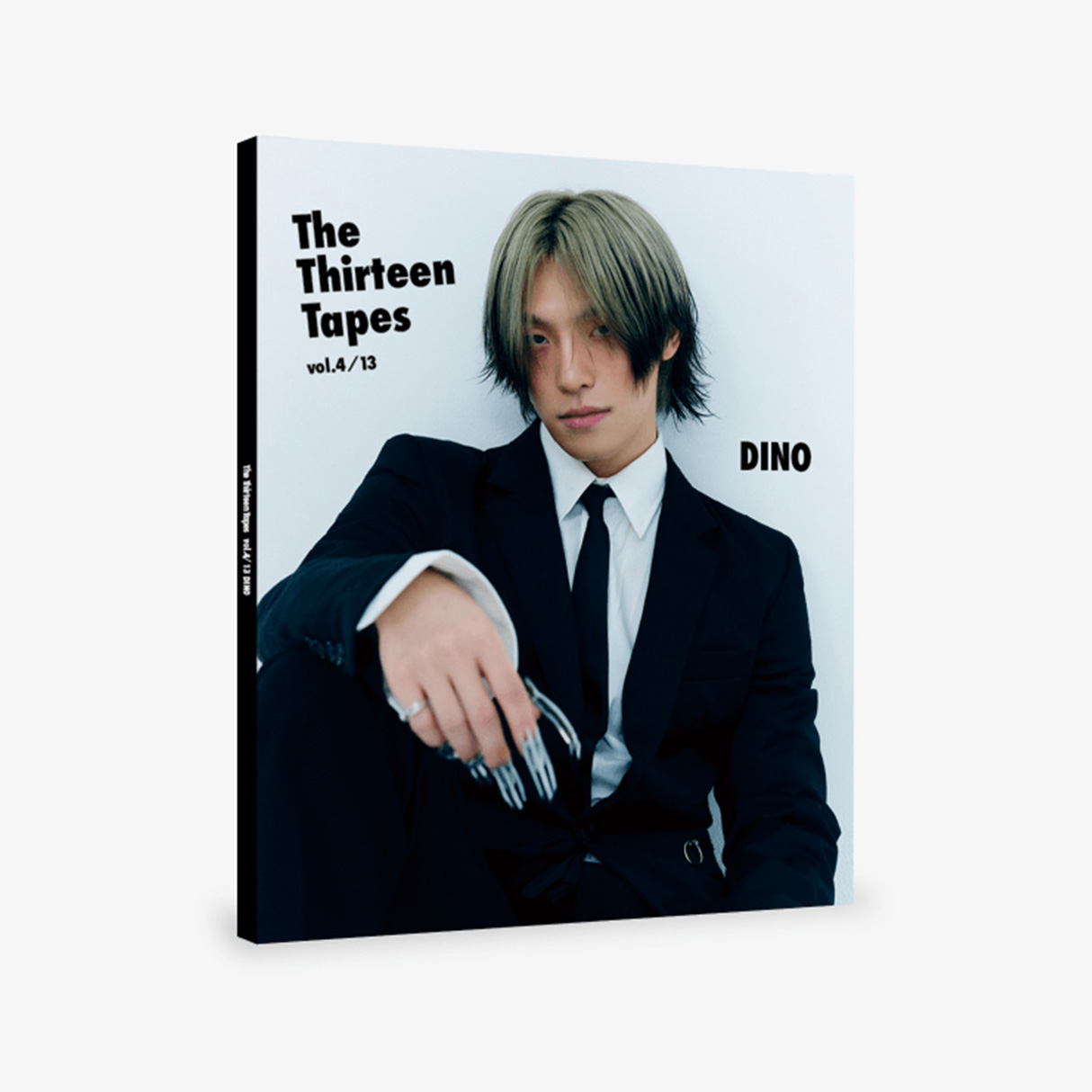
Unauthorized reproduction and distribution prohibited.

